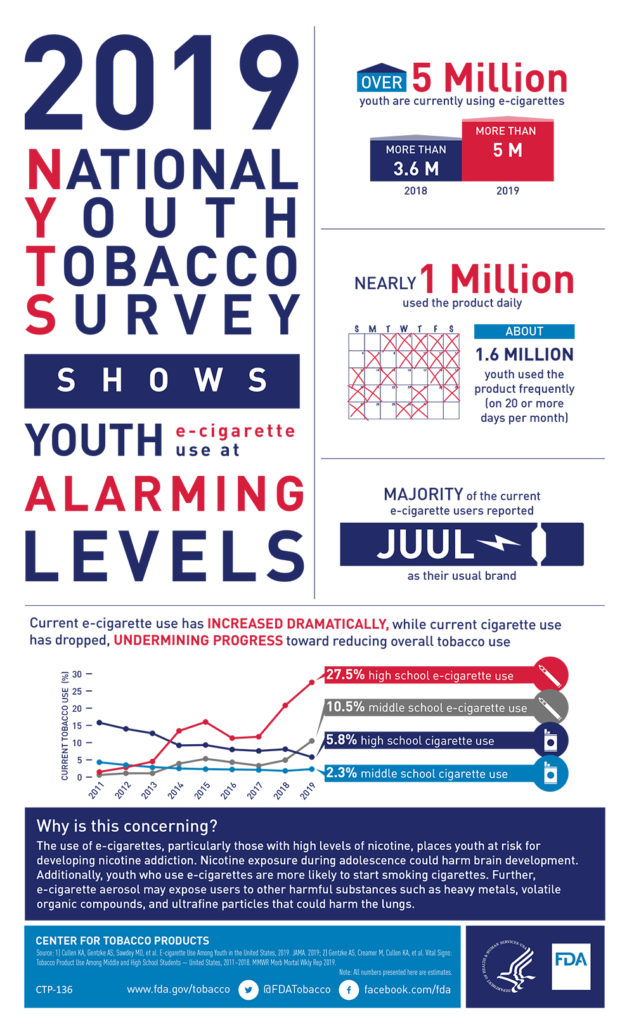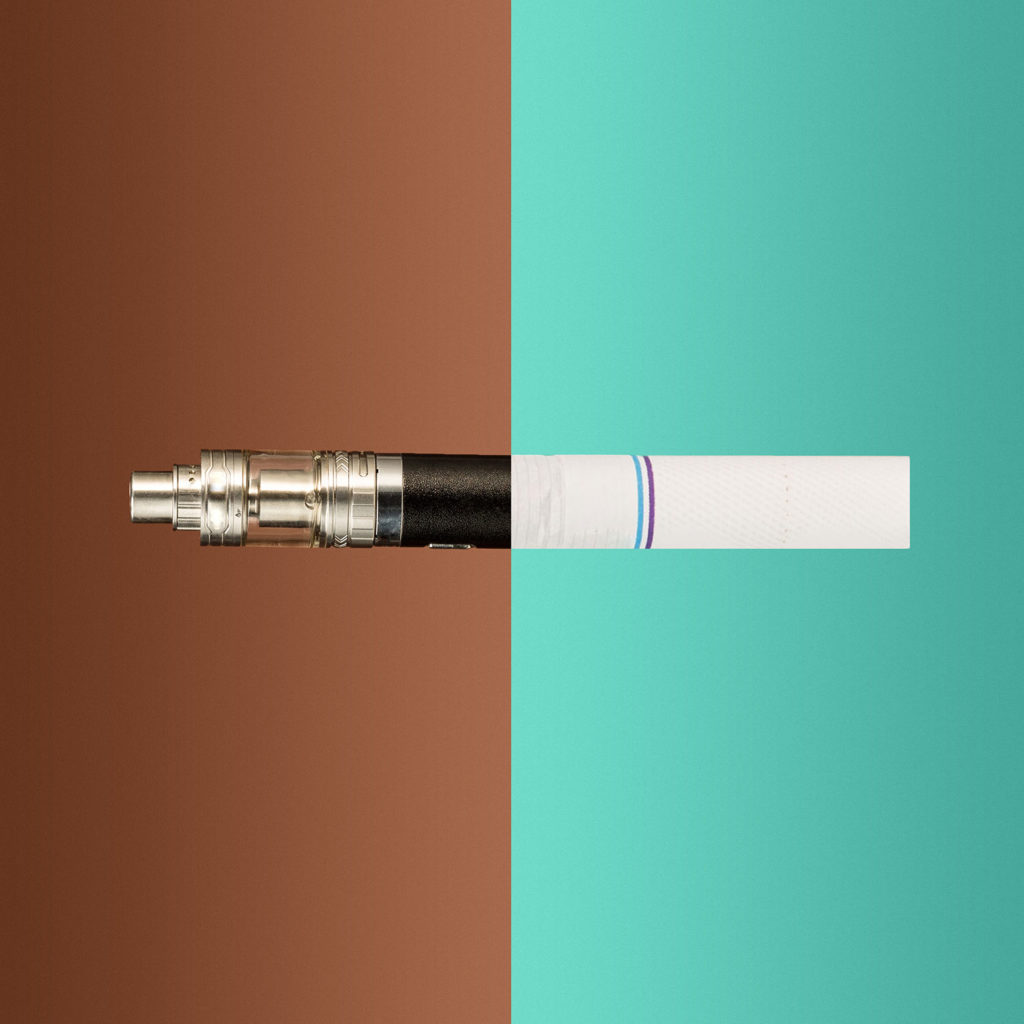Note: This blog is an update of an entry originally published earlier in 2019. Many new (tragic) developments have occurred, and we felt it appropriate to put all of the information in one place in an attempt to create a more comprehensive guide to JUULing.
Juuling, vaping – whatever you want to call it–it’s VERY popular and, unfortunately, VERY dangerous, as evidenced by the ongoing (and ever-growing) reports of related illnesses and deaths. As of December 27, 2019, a whopping 55 deaths have been caused by vaping, with one new fatality every 10 days, according to the Center for Disease Control (CDC). 2,561 cases of hospitalized e-cigarette, or vaping, product use associated lung injury have been reported to the CDC from 50 states, the District of Columbia, and 2 U.S. territories (Puerto Rico and U.S. Virgin Islands) – and this number just keeps on growing. The problem has reached such a level that the CDC has issued a health advisory urging people to avoid e-cigarettes and other vaping devices, and the illness associated with vaping now has a unique name: EVALI (E-cigarette- or Vaping-Associated Lung Injury).
And maybe the worst thing is: over 5 million middle and high school students now use e-cigarettes, up from 3.6 million last year, according to the National Youth Tobacco Study. That is truly disturbing.

Juul has become so popular that, as of earlier this year, it was reported to account for nearly 75% of the market share in the US e-cigarette market, leaping from about 40% market share in 2017, making it today’s best-selling e-cigarette brands in the US. According to the manufacturer, a single Juul pod contains as much nicotine as a PACK of 20 regular cigarettes. Alarmingly, however, approximately two-thirds of JUUL users aged 15 – 24 do not know that Juul ALWAYS contains nicotine. According to the Centers for Disease Control (CDC), in 2019, over 5 million U.S. middle and high school students used e-cigarettes in the past 30 days, including 10.5% of middle school students and 27.5% of high school students.
The US Surgeon General has declared youth vaping an epidemic, and has identified Juul as part of the problem, in an advisory issued late last year. You never want to hear “epidemic” and “extremely popular” in the same sentence, particularly when it relates to our youth, but that’s exactly what we’re looking at here. And given that Juul is under federal and state investigation for deliberately marketing to teenagers, as well as being the subject of a federal criminal probe, we definitely see quite a few bright red flags waving frantically about this issue.
Juul recently announced that it will pull all print, digital and TV advertising in the United States and will not fight legislation cracking down on e-cigarettes (Juul has said that it will not push back on a Trump administration plan to pull flavored e-cigarettes from the market until the products win approval from the FDA, but Trump has backed down on his original stance). In addition, Juul has voluntarily halted online sales of flavors such as mango and fruit in the United States after earlier pulling them from retail stores. Some states (including Massachusetts, New York and Michigan) and cities (such as San Francisco and Boulder) have also moved to ban the sale of all or some vaping products. These measures, although helpful, do not mean that the problem will simply disappear. As Denver’s first integrative pediatrician practice (founded in 1977), we have had serious concerns about Juuling, as well as vaping in general, and its implications for your child and family for some time now. We wrote about this issue earlier this year, but believe it is important to revisit this issue for parents around Metro Denver (and anywhere else) in light of the very alarming health trends and related information that have developed over the past year. And with the uncertainty surrounding what will happen legally with regard to JUULing and the accessibility of vaping products for teenagers, it’s a tricky time – and it’s important to be wary and knowledgeable so you can help your kids navigate these murky waters.

First, What Exactly is Juuling?
Juul hit the market in June 2015, a product of PAX Labs. JUUL is a battery-powered device that heats a nicotine-containing liquid to produce an aerosol that is inhaled. It has the size and look of a slightly elongated flash drive (which makes it very discreet and easy to hide), and uses pods containing liquid nicotine. As noted, each pod contains as much nicotine as a pack of 20 regular cigarettes and is designed to give the user a nicotine high within five minutes – similar to traditional cigarettes. Stanford Professor of Pediatrics Bonnie Halpern-Felsher – who studies nicotine – calls the amount in each pod “scary,” stating that the amount “is much higher than what we’re seeing in traditional e-cigarettes. It’s a tremendous amount.” This means that the product is designed to be highly addictive, thus ensuring continued purchases and ongoing usage. E-cigarette devices can also be used to deliver marijuana and other drugs.
Unlike many e-cigarettes, JUUL uses nicotine salts, which allow particularly high levels of nicotine to be inhaled more easily and with less irritation. Because the nicotine salt-based formula means Juul is less harsh, users are not readily aware of how much nicotine they’re taking into their system. According to the US Surgeon General, this is of particular concern for our youth “because it could make it easier for them to initiate the use of nicotine through these products and also could make it easier to progress to regular e-cigarette use and nicotine dependence.” The CDC has even stated that “young people who use e-cigarettes may be more likely to go on to use regular cigarettes.”
Because a Juul emits only a small amount of smoky vapor, it’s extremely discreet and easy to use indoors, including in school bathrooms and even classrooms. Unfortunately, e-cigarette aerosol is NOT harmless “water vapor.” As reported by the CDC, e-cigarette aerosol can contain both actually and potentially harmful substances (in addition to nicotine), including ultrafine particles that can be inhaled deep into the lungs, flavorings such as diacetyl (a chemical linked to a serious lung disease), volatile organic compounds, cancer-causing chemicals, and heavy metals (such as nickel, tin, and lead).
Targeting Teens
As we mentioned above, there are ongoing state and federal investigations, as well as a federal criminal probe, of Juul for deliberately marketing to teenagers. With fun flavors like cool cucumber, fruit medley, creme, mint and mango (Juul stopped selling mango, fruit, cucumber and creme pods in the United States on Oct. 17 of this year), its marketing focus on sex appeal, fun and youth (Juul was using 21 year-old models for quite some time) and its leveraging of youthful social media “influencers,” the appeal to teens is hard to miss. Add Juul’s easy-to-hide design into the mix (we all know how teenagers love to keep secrets), and you’ve got yourself a really problematic cocktail –in fact, an “epidemic” with potentially serious and life-changing consequences.

Health Risks
1) Addiction: Addiction to nicotine – especially at a young age – can create a variety of medical conditions that necessitate more and more health care and visits to your primary care doctor that wouldn’t have been necessary absent the addiction. Nicotine negatively impacts developing teens’ brains (which keep developing until about age 25), affecting their cognitive development and ability to think at a high level. Using nicotine in adolescence can harm the parts of the brain that control attention, learning, mood, and impulse control. Introducing an addiction to a substance like nicotine can also alter the course of a young brain’s development, causing undue anxiety, restlessness, hyperactivity and impulsiveness.
Teenagers are more susceptible to addiction because their brains are still maturing. Nicotine addiction at a young age can also lead to a heightened risk for lifelong addiction issues with other substances. And since many teens have no idea how much nicotine is in a Juul pod, or even necessarily how harmful nicotine can be, this creates a potentially enormous issue in the life of a teenager that could haunt them for decades.
And no, this isn’t just coming from our training as holistic pediatricians or from our integrative approach to conventional western medicine. This “epidemic” is an undeniable threat to our children’s health. Unfortunately, no amount of integrative medicine, conventional medicine or patient-centered natural healing – as safe and effective as they are – can magically cure addiction. It’s safe to say that being addicted to nicotine isn’t on the list of anyone’s recommendations for pediatric care.
2) EVALI: The CDC, FDA, state and local health departments, and other clinical and public health partners are investigating a national outbreak of e-cigarette, or vaping, product use associated lung injury (EVALI). As stated, as of December 27, 2019, 2,291 cases of hospitalized EVALI have been reported from 50 states, the District of Columbia, and Puerto Rico and the U.S. Virgin Islands, and forty-eight deaths have been confirmed in 25 states and the District of Columbia. The majority of the patients were male (68%) and under the age of 35 (77%), with a median age of 24 years and an age range from 13 to 78 years. Patients in many cases experienced gradual symptoms, including breathing difficulty, shortness of breath and chest pain before being hospitalized. Some people reported vomiting and diarrhea or other symptoms such as fevers or fatigue.
The CDC’s most recent update on the EVALI investigations notes:
- All EVALI patients have reported a history of using e-cigarette, or vaping, products.
- Vitamin E acetate has been identified as a chemical of concern among people with EVALI.
- THC (the main psychoactive compound in marijuana that gives the “high” sensation) is present in most of the samples tested by the FDA to date, and most patients report a history of using THC-containing e-cigarette, or vaping, products.
- The latest national and state findings suggest THC-containing e-cigarette, or vaping, products, particularly from informal sources like friends, or family, or in-person or online dealers, are linked to most of the cases and play a major role in the outbreak.
- While it appears that vitamin E acetate is associated with EVALI, evidence is not yet sufficient to rule out contribution of other chemicals of concern.
- Many different substances and product sources are still under investigation, and it may be that there is more than one cause of this outbreak.
Based on the above, the CDC recommends that:
- people not use THC-containing e-cigarette, or vaping, products, particularly from informal sources like friends, or family, or in-person or online dealers;
- people not add any substance to e-cigarette or vaping products that are not intended by the manufacturer, including products purchased through retail establishments; and
- vitamin E acetate not be added to e-cigarette, or vaping, products.
The only way your kids can be assured that they are not at risk is to REFRAIN from the use of ALL e-cigarette, or vaping, products, including Juul. In fact, the CDC has stated that, regardless of the ongoing investigation, e-cigarette, or vaping, products should never be used by youths, young adults, or women who are pregnant.
3) Poisoning: According to the American Academy of Pediatrics (AAP),
- e-cigarette solutions can poison children and adults through swallowing or skin contact. In fact, a child can be killed by very small amounts of nicotine–less than half a teaspoon.
- Symptoms of nicotine poisoning include sweating, dizziness, vomiting, increased heart rate lethargy, seizures, and difficulty breathing.
The AAP reports that calls to poison control centers related to e-cigarette devices have skyrocketed in the last 5 years. In 2014, US poison centers reported 3,783 exposures to e-cigarette devices and nicotine liquid, compared to only 1,543 exposures in 2013. In 2015, 3,073 exposures were reported.

How Do I Help Prevent E-Cigarettes From Harming My Children?
We all have our own unique ways of parenting that work great for our families, but in many cases, we find that simply talking to your kids about issues, such as Juuling/vaping, is the best medicine. Over the past 42 years, we’ve found that great pediatric health care is all about warm, caring relationships and open communication, and the same goes for all relationships with loved ones.
While we probably all roll our eyes when we look back at Public Service Announcements and “Very Special Episodes” of Saved By The Bell, there are some helpful resources for parents looking to speak to their kids about Juuling and e-cigarettes worth looking into. The Surgeon General has actually put together a helpful guide for doing just that.
Here are a few basic tips to keep in mind:
- Have a conversation, and don’t lecture or judge. Think back to when you were their age: your tolerance for being lectured by your parents, on a scale from 1 to 10, was probably about -37. Have a dialogue with them and try to understand and empathize with whatever they have to say. Maybe they’ve already made up their mind never to try Juuling, maybe they tried it and didn’t like it, or maybe they’re using it every day.
- Remember that there may be social pressures to fit in involved. Teenagers can be very cliquish, and will often do things primarily to fit in with their friends. If Juuling is an “in” thing at your kid’s school or in their social circle, there may be an aspect of fear of not fitting in – which you can empathize with.
- Learn the facts. Being able to speak credibly and back up your statements always helps. Check out some of the links we’ve included to help educate yourself ahead of time – and maybe even give you good material to share with your child.
- Be a good role model for your children by personally being tobacco-free.
- Set up an appointment with your child’s health care provider so that they can hear from a medical professional about the health risks of tobacco products, including e-cigarettes. We’re always happy to perform this function.
- Speak with your child’s teacher and school administrator about enforcement of tobacco-free school grounds policies and tobacco prevention curriculum.
- Adopt tobacco-free rules, including e-cigarettes, in your home and vehicle.
Closing Thoughts from a Denver Integrative Care Pediatrician
As much as we may want to sometimes, we can’t control everything our child does. That’s part of the beautiful challenge of being a child – and a parent. Juuling isn’t the first landmine we’ve encountered as a culture, and it won’t be the last, either. But it is a trend that warrants serious concern, and we want to support you and your family on your journey together. If you have any further questions about Juuling, we strongly encourage you to contact us and talk to your pediatrician about it. At Partners In Pediatrics, we strive to be your family’s true medical home, and we are here to do what we can to support you and your children. Stay healthy out there!
We’d also like to direct you to National Jewish Health’s My Life My Quit program, which is specifically geared toward helping teens quit smoking. They even have a texting option! Click here to check it out.



Leave a Reply